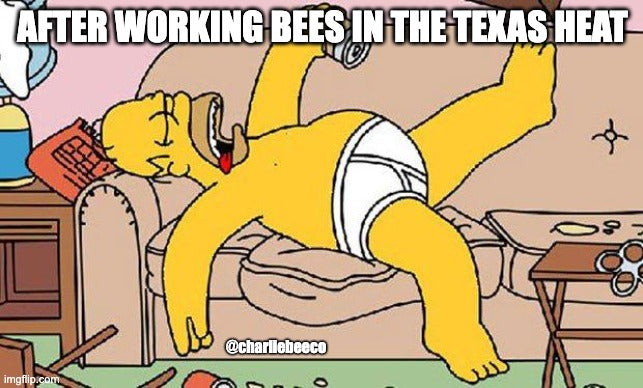Texas in August is like the world has turned to lava. Remember that childhood game? The floor is lava—only now it’s the air, the sun, the very ground beneath your boots.
As a Yankee with too much insulation around the middle, I often wonder what possessed me to end up in Texas, when my DNA is clearly tuned to overcast skies, peat bogs, and a pint in the dim shade of some Irish pub. Then I remember what makes this place great—barbecue, “bless your heart,” and the freedom to build and do business more or less unfettered.
Texas is just like the Northeast where I grew up, only in reverse—you can’t go outside for three months in the summer, not the winter.
But bee removal season doesn’t care about my Irish genes. Swarms that moved into someone’s wall back in spring are now big enough to sting the neighbors. That means we’re out in the heat all the time. Add in feeding bees and hive checks, and the “reasonable” daylight hours vanish quick.
I walk around like a swamp monster most of this time of year. In July I pushed too far and overheated, so now I’m extra careful. A bee suit is ventilated, yes, but it’s still a big swath of cloth. That’s why we “go buck”: boots, socks, and a bathing suit under the veil.
Lessons from “Bee Man Dan”
Years ago I worked a job with a fellow beekeeper, Bee Man Dan. The two of us were on a lift in the middle of a brutal Texas day, eighty feet in the air, working bees in full suits. It was pure hell. Dan had a system, though — he calculated his work/rest cycle based on the dew point and temperature.
The method was simple, if not particularly efficient: at certain points in the day we could only work 15 minutes before climbing down, ditching the suits, and sitting in the air conditioning for 45 minutes. Then back up, do another round, and retreat again. It wasn’t the fastest way to get through the job, but as Dan put it: “Neither is dying.”
That stuck with me. Efficiency doesn’t mean much if you don’t make it to the end of the day.
A PRACTICAL HEAT PROCEDURE FOR BEEKEEPERS
SET A TIMER BEFORE YOU SUIT UP
Don’t trust your body alone—when the sun is cooking, you’ll push past safe limits without realizing it. In mid-afternoon, limit stints in the bee suit to 15–20 minutes tops.
TAKE REAL COOL-DOWNS
Breaks don’t mean just standing in the shade scrolling your phone. Sit in AC or at least in front of a fan. Hydrate, ditch the suit, and let your body temp actually drop.
USE A 1:3 RATIO
For every 15 minutes in the suit, give yourself at least 30–45 minutes to recover. Sounds like overkill, but you’ll stay sharper and avoid the creeping fatigue that leads to mistakes.
WATCH THE SIGNS
Early – muscle cramps, heavy sweat, fatigue
Middle – headache, dizziness, nausea, tunnel vision, thumping pulse
Late (Danger Zone) – confusion, fainting, hot/dry skin, rapid pulse
At the first two stages, it’s time to tap out. Wait too long, and you’ll need an ER, not a Gatorade.
HYDRATE + REPLACE ELECTROLYTES
Water alone won’t cut it when you’re dripping buckets in a bee suit. Use electrolyte mixes or sports drinks.
PLAN AROUND THE HEAT
Do removals and heavy lifting early morning or late evening. Save the paperwork, honey bottling, or shop tinkering for the peak hours of the day.
Bottom Line
Beekeeping is already tough work. Add the Texas sun and a full suit, and it can push you into danger quick. Don’t measure your day by how much you got done—measure it by whether you made it home upright. Like Bee Man Dan taught me: work hard, then cool off harder.
Stay safe out there, y’all. Winter is coming.

